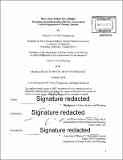Don't get taken for a ride! : designing and Implementing effective autonomous vehicle regulation in Toronto, Ontario
Author(s)
Gillies-Podgorecki, Benjamin M. (Benjamin Marshall)
DownloadFull printable version (19.20Mb)
Alternative title
Designing and Implementing effective autonomous vehicle regulation in Toronto, Ontario
Other Contributors
Massachusetts Institute of Technology. Department of Urban Studies and Planning.
Advisor
Jinhua Zhao.
Terms of use
Metadata
Show full item recordAbstract
Studies suggest autonomous vehicles can enable a more equitable, efficient, and sustainable transportation network. Yet, experts point out this outcome is not guaranteed, and that without outside policy intervention autonomous vehicle (AV) use might actually exacerbate congestion, sprawl, and inequitable access to travel. These challenges will be most acutely felt in areas under the purview of local governments-such as transportation congestion, land use, and impacts on public transit. As such, the goal of this thesis is to assist municipal policymakers with mitigating these impacts by answering the question: How can local governments effectively regulate autonomous vehicles? Looking at Toronto, Canada, specifically, this thesis addresses the following issues: - When is a contract, and when is a regulation, the most appropriate tool to encourage AV companies to act in ways that help foster a sustainable and equitable transportation network? - What does the City of Toronto require to develop effective AV regulation? - How can the City of Toronto codify broad AV policies into specific, enforceable regulations? This thesis employs three research methods: a literature review, a document analysis, and qualitative interviews with relevant experts. The primary literature review looks at the possible benefits and harms that might come from AV development and the policies local governments can enact to correct for these externalities. Interviews were conducted with 23 experts from the public and private sectors and academia, with responses analysed and themes drawn out to develop answers to the above research questions. Finally, analysis of Toronto's Official Plan and Municipal Code helped inform the creation of a proposed Article 10-A of the code to regulate AV rideshare companies. Chapters three to five of this thesis develop a framework (laid out in Figure 0.1) for thinking about how best to design effective AV regulation. Firstly, the government needs legal capacity to regulate in a given area. Toronto, for example, is responsible for overseeing local rideshare company activity. The remaining four elements all relate to human resources. Interviews show Toronto's bureaucrats believe they have a responsibility and ability to craft effective and ambitious regulations that advance the city's goals. These willing civil servants need the time and the expertise to design good policy, and the Toronto government has an AV working group that provides a forum for such a discussion. To see regulations enacted effectively, however, the mayor and council must not only support rules eventually proposed by the working group; they may also need to approach the provincial government to convince them to craft their own complementary AV legislation. Figure 0.1. The five elements to effective regulation [illustration] Chapter six explores how broad AV policy can be applied concretely. Along with Article 10-A (Appendix C), it offers an example of the specific legal language for AV regulation. Divided into two broad categories--'Equity' and 'Urban Form and Street Space'-the article addresses some of the anticipated issues that might arise with AV rideshare operations including a need to allow citizens without a smartphone are able to use the service, limit AV rideshare travel on local roads, and ensure all neighbourhoods enjoy a relatively similar level of service (accounting for geography and density). Beyond the proposed article itself, chapter six provides feedback from Toronto officials as to the challenges the provisions in the article might face were the government to attempt their ratification. Positively, none of the regulations were unanimously viewed as infeasible, with staff seemingly eager to act boldly when it comes to addressing the challenges of AV activity. As such, this thesis can be used both by Toronto policymakers and their counterparts elsewhere as the basis for discussion in designing the specific rules for AV operations that will be incorporated into a future version of the Municipal Code.
Description
Thesis: M.C.P., Massachusetts Institute of Technology, Department of Urban Studies and Planning, 2018. Cataloged from PDF version of thesis. Includes bibliographical references (pages 162-169).
Date issued
2018Department
Massachusetts Institute of Technology. Department of Urban Studies and PlanningPublisher
Massachusetts Institute of Technology
Keywords
Urban Studies and Planning.